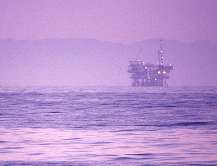

NEW! Acoustic Ecology Institute has put together a concise, comprehensive Backgrounder on industrial seismic surveys. This 8-page Word document (designed for the media) gives a quick overview of the issue; detailed summaries of the scope, effects, and possible ways of addressing the issue; 2004 research of note; and links to online resources. [DOWNLOAD BACKGROUNDER(doc)] Seismic surveys utilize arrays of airguns to produce powerful sound waves; with sophisticated acoustic processing the echoes from these sound waves can provide information about geological structure up to 40km below the sea floor. Seismic surveys are used by academic geologists to study plate tectonics and other topics, and by the oil and gas industry in its search for new hydrocarbon deposits. There are a handful of seismic survey ships worldwide that are contracted by academic institutions for their studies. At times, these studies move beyond "pure science" and can involve data collection designed at least secondarily for assessing the potential for energy development. Academic surveys use anywhere from 1 to 20 airguns in their arrays; it is quiet common for these surveys to use 6-12 guns. The standard "safety radius" is 500-1000m, though it can be less on small-array projects.; operations stops when whales are in or approaching this distance from the ship. The ship whose permits have been most often challenged by environmental advocates is the R/V Maurice Ewing, owned by the National Science Foundation and operated by Columbia University's Lamont-Doherty Earth Observatory. The Ewing generally does 4-8 surveys per year, each one lasting between a few days and a couple weeks. It has participated in controlled exposure experiments designed to measure the response of sperm whales to airgun sounds, and runs regular calibration cruises, the most recent of which revealed that sound transmission in shallow water is much stronger than previously believed (since then, the Ewing has expanded its "safety zone" accordingly, to up to a 3000m radius). Meanwhile, there are about 100 industrial ships equipped with airguns, with 20-30 active at most times, and one or more surveys underway worldwide on most days. Industrial surveys are far more apt to use full-power 20-gun arrays (academic arrays typically make more of an effort to use smaller arrays when possible); however, the standard safety radius is just 500m. Industrial seismic surveys have been in operation worldwide for decades, with relatively few reports of obvious harm to sea life. While there are some questions about whether injured animals would sink out of sight, it seems fairly clear that in most cases, the loud airguns scare fish and cetaceans away. The biological effects of such displacement are not well studied, and there is some evidence of long-term hearing damage in cetaceans that may be related to chronic airgun or ship noise. During 2004, bioacousticians have begun reporting that airgun noise from distant surveys along the coasts of South America and Africa are the dominant sounds in some mid-Atlantic study sites, making it difficult or impossible to hear the whales or seaquakes they are trying to study. Airgun noise is over 200dB at the source, drops quickly to under 180dB (usually within 50-500m, depending on source level and local conditions), and continues to drop rapidly over the next few kilometers, until leveling off at somewhere around 100dB. At this level, the sound can travel for hundreds or thousands of kilometers; in many or most locations, 100dB is significantly louder than the existing ambient background noise, so the airguns raise the background noise to this level, potentially masking local biological calls and signals. It is difficult to track industrial survey plans, which are often considered trade secrets, and involve permitting from countries around the world. Some countries have begun to take a harder look at airgun noise; during 2004, Mexico has rejected permits for both academic and industrial surveys, and Brazil is prohibiting surveys near a key marine reserve. Still, worldwide awareness of the long-range acoustic effects of surveys is only beginning to develop. Areas with high levels of seismic survey activity include the Gulf of Mexico, North Sea, Australia, Brazil, West Africa, and Indonesia. Expansion of exploration activity is taking place along the north slope of Alaska and Canada, New Zealand, and the Indian Ocean. US National Archive of Marine Seismic Surveys (NAMSS) - Online maps/database put together by the USGS [WEBSITE] |
|||||||||||||||||||||||
| © AcousticEcology.org, 2001 | Privacy Policy | Site Map |
